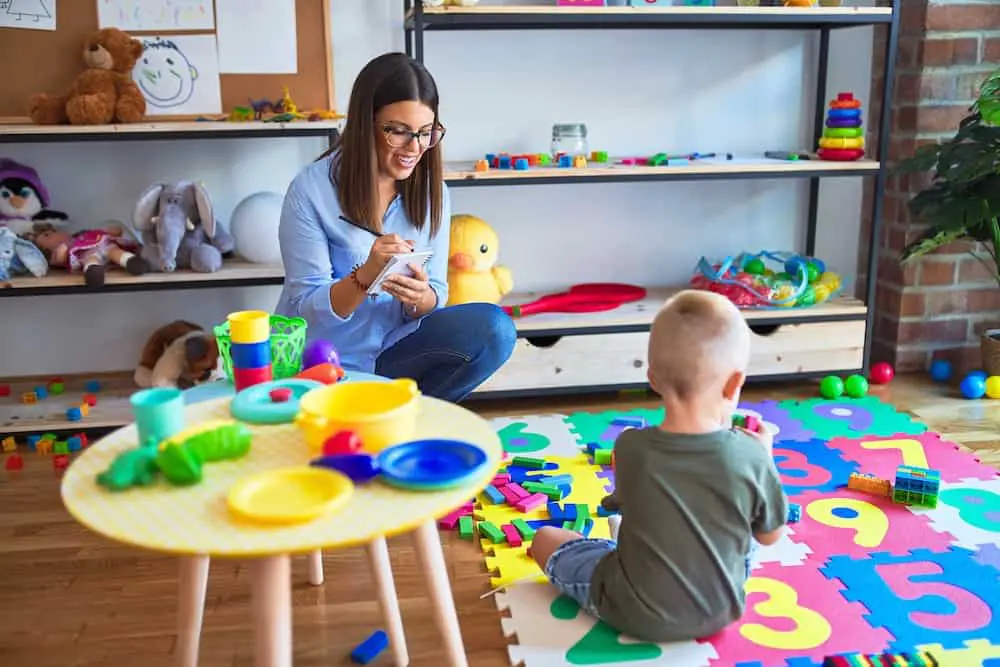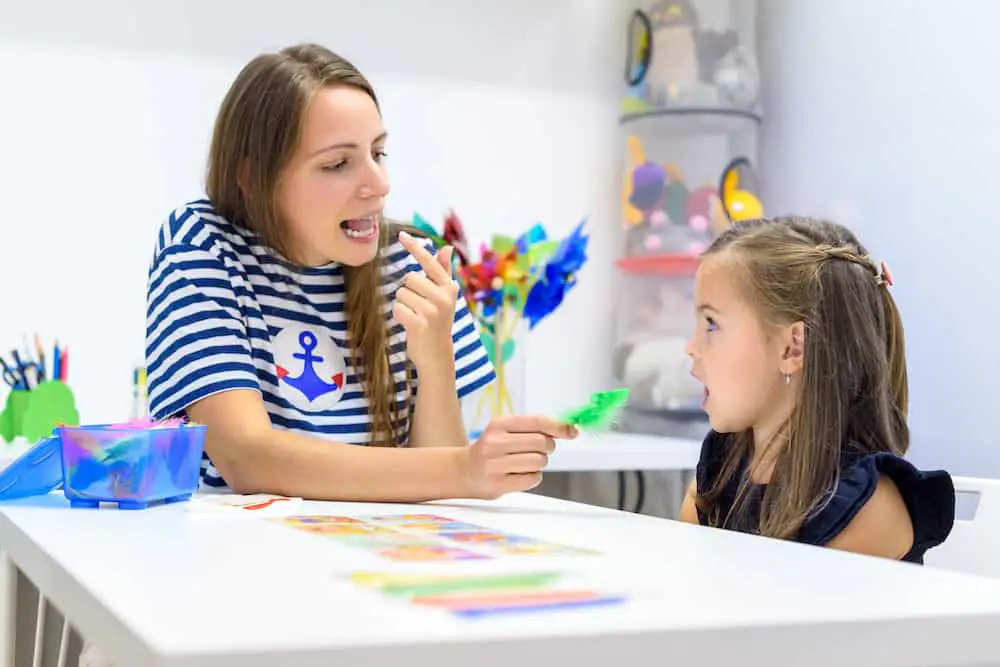Speech-language pathologists or SLPs offer different types of treatments to help children develop their level of communication.
However, preschool speech therapy activities are not exclusive for SLPs to facilitate.
Family members play a vital role in enhancing a child’s language capabilities.
To assist your child in his journey, listed below are different activities that will help in pronunciation, fluency, and general social skills.
Preschool Speech Therapy Activities
Toddlers, especially those with communication challenges, need to have a regular dose of different speech therapy activities.
Understanding their struggles and possible disorders at an early age will go a long way in their treatment.
With that in mind, let’s explore some language activities you can do with your preschooler.
1. Reading Books
Reading a book with many playful images and easy words is one of the most effective speech therapy activities for young kids.
In choosing a book for your preschooler, keep in mind the types of books you should look for.
Repetitive Books
Generally, toddlers will enjoy books with predictable, repetitive phrases.
The language and repetition in these books will capture their interest and make it simpler to recall essential words and phrases.
It will also help if you’ll include a rhythm to the words for better retention.
You may consider these repetitive books if you’re not sure which ones to purchase:
- Goodnight Moon (Margaret Wise Brown)
- Have You Seen My Cat (Eric Carle)
- Jesse Bear, What Will you Wear? (Nancy White Carlstrom)
Simple Storybooks
Owl Moon is one of the classic examples of this type of book.
It tells a simple yet exciting story about a girl who wanted to encounter a legendary creature.
This kind of narrative can certainly draw preschoolers to the book and, as a result, help their language skills.
Other notable examples are:
- The Three Ninja Pigs (Corey Rosen Schwartz)
- How I Became a Pirate (Melinda Long)
- Bear’s New Friend (Karma Wilson)
Non-Fiction Books
While non-fiction stories may not be appealing to preschoolers, these books would better expose children to new vocabulary.
The Mouth With a Mind of Its Own is a popular non-fiction book that tells a story about a boy whose mind is not in sync with his mouth.
Homemade Books
Do you prefer a more personalized touch when reading books to your preschooler?
If so, you can use familiar images such as family photos.
From there, make a book and create a simple storyline based on the pictures you have.

2. Toys
Playing with toys is one of the most natural ways to aid children in enhancing their language capacity.
In fact, it’s pretty common for SLPs to recommend playing with toys.
They view it as one of the best speech therapy activities because it encourages interaction.
There are plenty of toys available for preschoolers, but many are not really for speech therapy.
Here are examples of toys that will help your child develop his speech:
Wooden Blocks
Arguably the most classic preschool toy, wooden blocks are not only educational but also offer fun for toddlers.
You’ll be able to teach the shape and color of a particular wooden block whenever they try to stack them.
Some sets feature painted letters on each block to help teach kids spelling early on, which will be beneficial once they reach school age.
Toy Farm
Playing with a toy farm could effectively teach preschoolers about different animals.
You’ll be able to teach easy-to-pronounce words such as cow, goat, pig, and more. Plus, visual recognition will also improve.
There are numerous ways to incorporate learning with the use of a toy farm.
Wheeled Toys
Any list of children’s toys is not complete without mentioning toy cars, fire trucks, police cars, and others.
Also referred to as activity toys, they help motivate children to move.
The movement will stimulate their excitement and might trigger them to make plenty of sounds.
Continuous making of sounds is helpful to their development of speech and language.
Ride-On Toys
Again, ride-on toys make children move and are proven excellent for fundamental speech developments.
You can tell your child where to drive the toy, either around the corner, between the seats, or beside the bed.
By guiding them, they will gradually get used to following directions.
This activity also provides you with an excellent opportunity to practice words such as go, stop, left, right, and more.
3. Blowing Bubbles
Playing with bubbles is fun and a helpful activity in targeting various oral or mouth skills.
For example, blowing exercises enhance the tongue’s ability to produce sounds like the consonants K and G.
Besides those sounds, there are various action words, verbs, and descriptions that children might learn while blowing bubbles.
In addition to oral exercises, this activity also promotes functions such as eye contact and joint attention.
Here are some bubble-related activities that you can try with your kid.
- Turning and Waiting
Toddlers can learn basic social skills by listening to comments and requests while blowing bubbles.
- Follow the Leader
Work with bubbles while executing simple actions for the children to imitate.
It will enhance their ability to move different body parts without much use of instructional words.
4. Singing Songs
Music is an excellent element in language and speech classes.
Preschoolers typically enjoy singing songs, which will do wonders for their self-confidence.
Children with established self-confidence often have better results in speech therapy.
Although some may be timid and inhibited during regular therapy, singing will positively change their demeanor.
SLPs utilize repetitive books with catchy tunes to entice children to engage in the activity.
Let’s explore a few notable speech therapy songs for children.
- If You’re Happy and You Know it
- Head, Shoulders, Knees, and Toes
- Twinkle, Twinkle Little Star
- Ring Around the Rosy
- Old MacDonald Had a Farm
Virtual Preschool Speech Therapy Activities
Doing fun speech therapy activities outside can produce significant progress.
However, there’s also plenty of available methods you can use even if you’re not physically present with your child.
Virtual speech therapy has rapidly become a standard practice in school districts and all over the world.
Many speech therapy exercises may still be practically carried out for preschoolers at home.
There are numerous activities available to SLPs during their virtual sessions. Some of them are:
Board Games
Interactive board games are a boon for parents and SLPs, as they can naturally enhance vocabulary while maintaining the element of fun.
Chutes and Ladders, Pop-Up Pirate, and Frida’s Fruit Fiesta are popular speech therapy board games for toddlers.
Fun Quizzes
Preschoolers may not be very receptive when it comes to direct questions.
However, you can take advantage of the technology to test their progress.
For example, use familiar images you see on the web to know if they can recognize them.
Interactive Games
Thanks to technology, games are available on the internet for young kids to play with words and sounds.
Plenty of apps are available for children and parents, as well as SLPs, to use in practicing speech.
ABCsmouse, Monkey Preschool Lunchbox, and Balloon Pop are some of the popular choices.
Conclusion
While there are many speech therapy activities available for everyone, it doesn’t mean that there’s no need for an SLP.
Treating a child’s language disorder will be difficult unless the team works hard to achieve it.
That team consists of the parents and the speech-language pathologists who will both ensure the child gets all the support needed.
Regardless of which activity you prefer, it would be advisable to consult first with your SLP.

